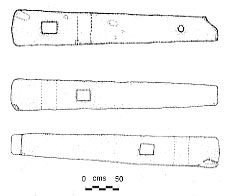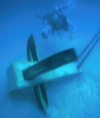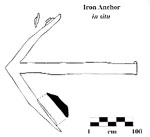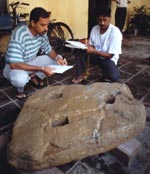 |
|
Maritime
Lanka |
6 Jan 2002
|
|||
| Last modified: 6 Jan 2002 |
|
||
 |
||
|
Several stone anchors have been found clustered together near the Black Fort in the area of Kamba Bandina Gala, a traditional mooring site for the lighter vessels which ferried cargo between large ships and the jetties. Anchors are not only found in association with wrecks: ships lose anchors frequently, because they jam or because they are not properly secured - see the eyewitness account of the Hercules disaster, in which the anchor was thrown overboard without first tying it to the ship. Old anchors may also be used as fixed moorings.
 One
large anchor of Arab-Indian pattern was recovered in 1997, and two broken anchors
of similar type have been found. Several dozen of these anchors have been found
in the Indian Ocean and the Red Sea, with the largest concentrations near Qalhat
in Oman. The stone of the large anchor has been analysed, and is also believed
to be from Oman. The anchor is estimated to weigh almost a ton, so must have
belonged to a ship of some size. It bears witness to the Arabian vessels which
pioneered the sea route to China and are believed to have dominated regional
trade until the arrival of the Europeans.
One
large anchor of Arab-Indian pattern was recovered in 1997, and two broken anchors
of similar type have been found. Several dozen of these anchors have been found
in the Indian Ocean and the Red Sea, with the largest concentrations near Qalhat
in Oman. The stone of the large anchor has been analysed, and is also believed
to be from Oman. The anchor is estimated to weigh almost a ton, so must have
belonged to a ship of some size. It bears witness to the Arabian vessels which
pioneered the sea route to China and are believed to have dominated regional
trade until the arrival of the Europeans.
Under the large anchor were two pieces of dense hardwood, in a position suggesting that these were the arms of the anchor. This is the first time that wood has been found in association with one of these anchors. Analysis has shown that the timber is from the late fifteenth or early sixteenth century, perhaps just preceding the arrival of the Portuguese. The anchor itself may of course be older, as timber arms would have required frequent replacement.

 One
anchor was found of Mediterranean pattern, also known as Byzantine-Arab style.
These anchors were used in ancient times, as far back as the third millennium
BC, but were also in use until recently in the Persian Gulf.
One
anchor was found of Mediterranean pattern, also known as Byzantine-Arab style.
These anchors were used in ancient times, as far back as the third millennium
BC, but were also in use until recently in the Persian Gulf.
One large iron anchor (3.2m long, with the end of the shank apparently missing, and 3.9m across the arms) was found near the stone anchors. It appears to be of the Old Plan Long Shank Pattern, similar to examples from the British warship HMS Sirius wrecked on Norfolk Island in 1790. (The Royal Navy was constantly experimenting with anchor designs, and their evolution may be seen in the collection in front of the National Maritime Museum at Greenwich.)
| Maritime Lanka homepage | Zheng He's trilingual inscription |